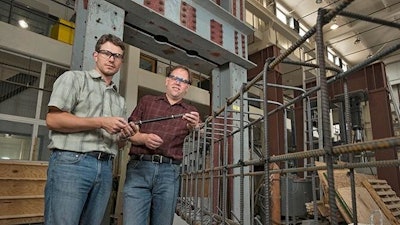
In August 2007, the I-35W Bridge over the Mississippi River in Minneapolis collapsed, killing 13 people and injuring 145.
Each day in 2016, there are nearly 204 million crossings on 58,495 U.S. structurally deficient bridges that are in need of repair.
Design matters
So what can we do? Engineers suggest preventing deficient bridges starts with proper bridge design and research.
“We need to revisit current standards with the benefit of much more extensive research,” says George C. Lee, special tasks director at Multidisciplinary Center for Earthquake Engineering Research, Buffalo, NY. “We need to install monitoring devices to record stresses on bridges. Of course, we need to examine what happens during catastrophic failure such as the Minneapolis bridge collapse, but we also need to study and learn from incidents of lesser damage and close calls.”
Bridge design and engineering has advanced significantly in the latter half of the past century because bridge designers and engineers applied lessons learned from those series of bridge failures. Despite these advances, however, the United States has continued to experience major bridge collapses.
“Those failures happened because we don’t know enough about the dynamic effects that extreme loads have on structures,” Lee says. “That is why the United States, in addition to needing to increase spending to maintain its infrastructure, also needs to invest in the research and information systems that will tell engineers how to avert future disasters.”
Lee says that researchers need to examine both the failure of materials at the microscopic level and the progressive failure of entire bridge systems.
“They should further develop computer modeling of nonlinear dynamics during bridge failure. Working with economists and risk analysts, they should seek better understanding of methods for minimizing costs during the life of the bridge. But these studies would largely be extensions and developments of research that is already proceeding.
“We argue that the United States needs to invest in new national R&D initiative, one that monitors and reports on bridge performance and bridge failures electronically through smart sensor networks incorporated into bridges. The nation needs to move its transportation systems into the digital age.”
Trouble seeking nanobites
While the Minneapolis collapse is nearly 10 years in the rearview mirror, researchers are doing just what Professor Lee suggests, developing new structural health monitoring systems that could avert such disasters in the future.
The unfortunate truth is that when a bridge ages, damage and defects are often invisible until it’s too late. A bridge designed to current standards and properly maintained can still fail. And so the search has been on for systems that can monitor the health of structures and alert their owners to potential problems and even impending catastrophic failure.
Several years ago, Erik Thostenson and Thomas Schumacher, both affiliated faculty members in the University of Delaware's Center for Composite Materials, received a $300,000 grant to investigate the use of carbon nanotube composites as a kind of "smart skin" for structures.
In preliminary research, the two found that a carbon nanotube hybrid glass-fiber composite attached to small-scale concrete beams formed a continuous conductive skin that is exceptionally sensitive to changes in strain as well as to the development and growth of damage.
"This sensor can either be structural, where the layer of the fiber composite adds reinforcement to a deficient or damaged structure, or nonstructural, where the layer acts merely as a sensing skin," says Schumacher, who brings to the project knowledge of structural mechanics and health monitoring of large-scale structures.
Today, they have improved on this approach. The new method applies a noninvasive medical imaging technique to the carbon nanotube-based sensor.
This is done through the addition of another technique called electrical impedance tomography (EIT), which uses surface electrode measurements to create an image of the conductivity of a material or structure.
The recent paper documents the team's initial evaluation of the methodology, first by introducing well-defined damage and then by investigating a more realistic damage scenario to show the capability of the approach to detect impact damage on a composite laminate. The resulting EIT maps were then compared to visual inspection and thermograms taken with an infrared camera.
"Although we did encounter some issues with the size of cracks being overestimated and their shapes not being well represented, overall our EIT methodology was able to detect the initiation of damage well before it was visible with infrared thermography," Schumacher says. "We are in the process of making improvements to the EIT algorithm to increase its accuracy. After that, we plan to demonstrate it in the laboratory, with an aim toward scaling it up for future monitoring of real structures."
Additional information provided by the University of Delaware.
















